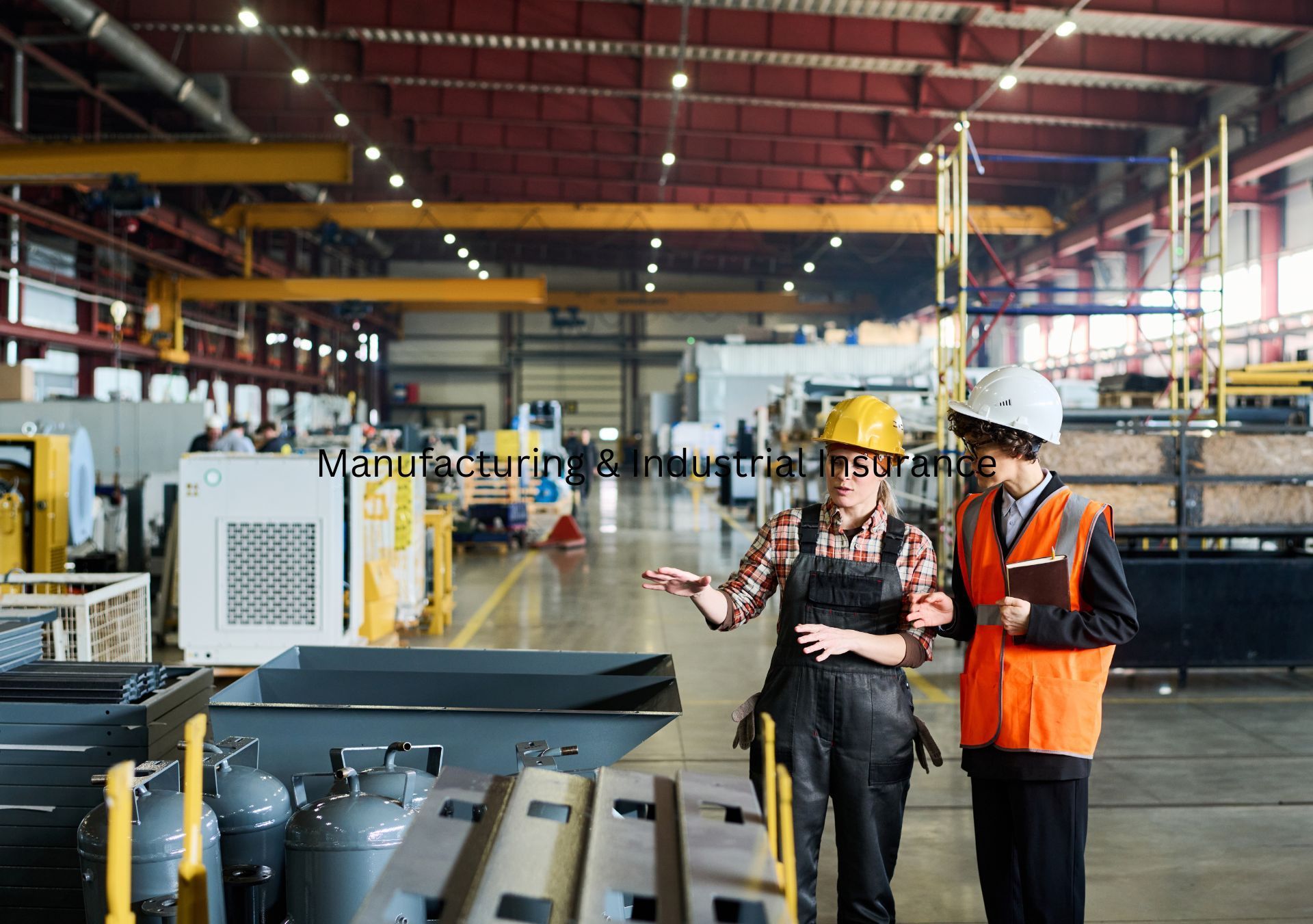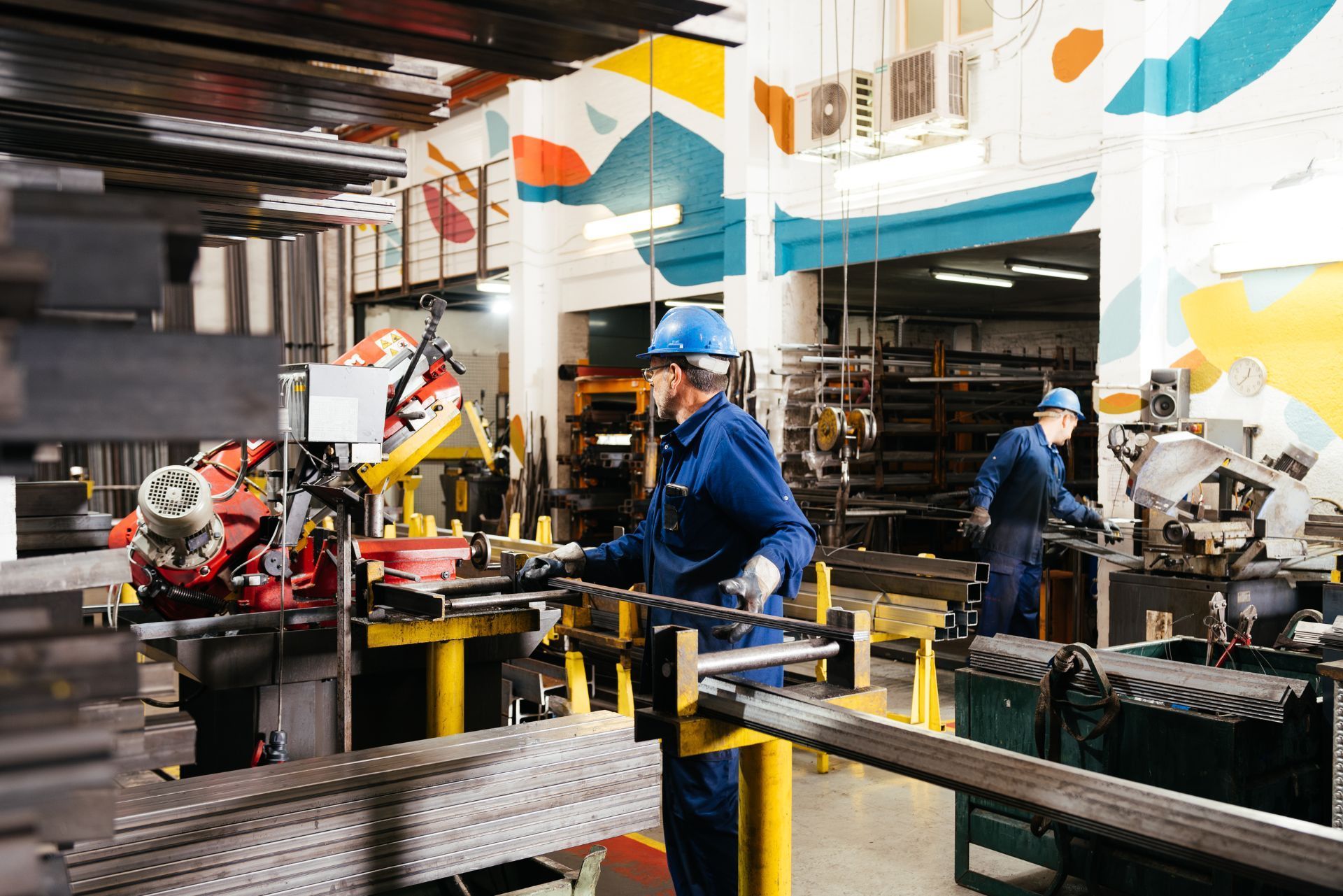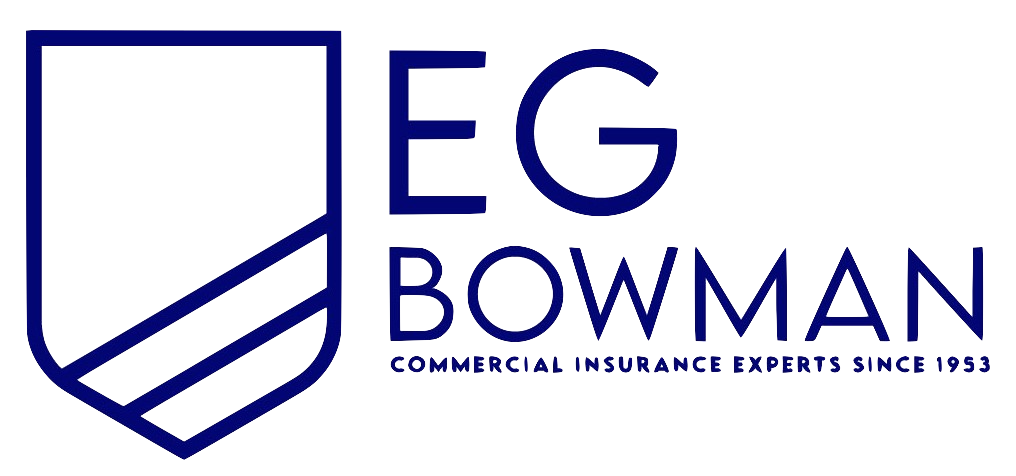Manufacturing & Industrial Insurance
See How We're Different:
or Call Us: 212-425-8150

Most Common Business Policies
Index
Understanding the Manufacturing and Industrial Landscape
Types of Manufacturing & Industrial Insurance Coverage
Assessing Your Manufacturing Insurance Needs
Common Challenges in Manufacturing Insurance and How to Overcome Them
Tips for Selecting the Right Insurance Provider
Contact Us
In the dynamic world of manufacturing and industrial operations, risks are an inherent part of the business landscape. From machinery breakdowns to workplace injuries, companies face a wide array of potential challenges that can disrupt production, impact financial stability, and threaten long-term success. Manufacturing and industrial insurance is designed to mitigate these risks, providing essential protection tailored to the unique needs of this sector.
This comprehensive guide explores everything you need to know about manufacturing and industrial insurance — from the types of coverage available and why they matter, to how businesses can assess their insurance needs and navigate claims effectively. Whether you are a small manufacturer or a large industrial enterprise, understanding these insurance essentials is critical for safeguarding your operations and ensuring resilience in an ever-evolving market.
Understanding the Manufacturing and Industrial Landscape
The manufacturing and industrial sectors form the backbone of many economies worldwide. According to the International Labour Organization, manufacturing accounts for nearly 16% of global GDP and employs over 450 million people globally. These industries encompass a broad range of activities including the production of goods, processing of raw materials, and heavy industrial operations. The significance of these sectors extends beyond mere economic metrics; they are also pivotal in driving innovation, enhancing productivity, and fostering technological advancements that can lead to sustainable practices.
Because of the complexity and scale of these operations, manufacturers and industrial firms face distinct risks such as equipment failure, supply chain interruptions, environmental hazards, and workforce safety concerns. These risks can lead to significant financial losses, legal liabilities, and reputational damage if not properly managed. Furthermore, the rapid pace of globalization and digital transformation presents both challenges and opportunities, as companies must adapt to new technologies while navigating a landscape that is increasingly interconnected and competitive.
Key Risks in Manufacturing and Industrial Operations
Identifying the specific risks that manufacturing and industrial companies face is the first step in understanding the importance of insurance. Some of the most common risks include:
- Property Damage: Factories and plants often house expensive machinery and infrastructure that can be damaged by fire, natural disasters, or accidents. The financial implications of such damage can be staggering, necessitating robust risk management strategies and insurance coverage to mitigate potential losses.
- Equipment Breakdown: Malfunction or failure of critical machinery can halt production, leading to costly downtime. Regular maintenance and timely upgrades are essential to minimize the risk of breakdowns, but even the best-laid plans can be thwarted by unexpected failures.
- Workplace Injuries: Manufacturing environments can be hazardous, with risks of accidents, chemical exposure, and repetitive strain injuries. Implementing comprehensive safety training and adhering to strict regulatory standards is crucial to protect employees and reduce the likelihood of incidents.
- Product Liability: Defective products can result in lawsuits and recalls, impacting brand reputation and finances. Manufacturers must invest in quality control processes to ensure that all products meet safety standards and customer expectations.
- Environmental Risks: Industrial processes may involve hazardous materials that pose environmental contamination risks. Companies are increasingly held accountable for their environmental footprint, prompting many to adopt greener practices and technologies.
- Supply Chain Disruptions: Delays or failures in the supply chain can affect production schedules and customer satisfaction. The recent global events have highlighted the vulnerabilities within supply chains, urging businesses to diversify their sources and enhance their logistical strategies.
Moreover, as the manufacturing landscape evolves with the integration of smart technologies and automation, new risks emerge alongside the benefits. The rise of Industry 4.0, characterized by the interconnectivity of machines and data-driven decision-making, presents unique cybersecurity threats that companies must address. Protecting sensitive data and ensuring the integrity of automated systems is now as critical as maintaining physical machinery. As manufacturers embrace these advancements, they must also develop comprehensive risk management frameworks that encompass both traditional and emerging threats, ensuring resilience in an ever-changing industrial landscape.

Types of Manufacturing & Industrial Insurance Coverage
Manufacturing and industrial insurance is not a one-size-fits-all solution. Instead, it comprises a portfolio of coverages designed to address the multifaceted risks these businesses face. Below is an overview of the most critical types of insurance coverage for manufacturers and industrial companies.
1. Property Insurance
Property insurance protects physical assets such as buildings, machinery, inventory, and raw materials against damage or loss caused by fire, theft, vandalism, storms, and other perils. Given the high value of equipment in manufacturing plants, this coverage is fundamental.
For example, a fire at a manufacturing facility can result in millions of dollars in damages and lost production time. Property insurance helps cover repair or replacement costs, minimizing financial disruption. Additionally, manufacturers often invest in specialized machinery that is not only expensive but also critical to their production processes. The loss of such equipment can lead to significant delays in fulfilling orders, affecting customer relationships and overall market competitiveness.
2. Equipment Breakdown Insurance
Also known as boiler and machinery insurance, equipment breakdown coverage specifically protects against the sudden and accidental breakdown of machinery and equipment. This includes mechanical failures, electrical surges, and other internal malfunctions.
Downtime due to equipment failure can be extremely costly. According to a study by the Uptime Institute, unplanned downtime in manufacturing can cost companies an average of $260,000 per hour. Equipment breakdown insurance helps cover repair costs and business interruption losses during these periods. Furthermore, as technology advances, many manufacturers are integrating complex automated systems that require specialized maintenance. This insurance not only safeguards against immediate financial loss but also encourages proactive maintenance practices to mitigate future risks.
3. General Liability Insurance
General liability insurance provides coverage for third-party claims related to bodily injury, property damage, and personal injury occurring on the business premises or due to business operations. This is essential for protecting manufacturers against lawsuits from customers, vendors, or visitors.
For instance, if a visitor is injured on the factory floor due to a slip and fall, general liability insurance can cover medical expenses and legal fees. Moreover, this coverage can extend to incidents that occur off-site, such as during product demonstrations or trade shows, thereby offering a broader safety net for manufacturers engaging in various promotional activities.
4. Workers’ Compensation Insurance
Given the physical nature of manufacturing work, workplace injuries are a significant risk. Workers’ compensation insurance covers medical expenses, rehabilitation costs, and lost wages for employees injured on the job. It also protects employers from potential lawsuits related to workplace injuries.
In the United States, workers’ compensation is mandatory in most states, reflecting its critical role in protecting both employees and employers. Additionally, many manufacturers are now focusing on workplace safety programs to reduce injury rates, which can also lead to lower insurance premiums over time. By investing in safety training and ergonomic equipment, companies not only comply with regulations but also foster a culture of safety that can enhance employee morale and productivity.
5. Product Liability Insurance
Product liability insurance protects manufacturers against claims arising from defective products that cause injury or property damage. This coverage is vital for companies that produce consumer goods, industrial components, or machinery.
Recall costs, legal defense fees, and settlements can be financially devastating without this protection. For example, a faulty automotive part causing accidents could result in multi-million dollar lawsuits. Furthermore, with the rise of e-commerce, manufacturers must also consider the implications of selling products online, where the risk of claims can be heightened due to the broader reach and visibility of their products.
6. Business Interruption Insurance
Also known as business income insurance, this coverage compensates for lost income and ongoing expenses when a business is forced to suspend operations due to a covered peril such as fire or natural disaster.
Manufacturing facilities often operate on tight schedules and just-in-time inventory systems, making downtime particularly damaging. Business interruption insurance helps maintain financial stability during recovery periods. Additionally, this coverage can be crucial for businesses that rely on seasonal production cycles, as it can help mitigate the impact of unexpected disruptions during peak operational times.
7. Environmental Liability Insurance
Industrial operations can pose environmental risks including pollution, chemical spills, and contamination. Environmental liability insurance covers cleanup costs, third-party claims, and regulatory fines associated with environmental damage.
This coverage is increasingly important as governments enforce stricter environmental regulations and penalties. Manufacturers are also under growing pressure from consumers and advocacy groups to adopt sustainable practices. By having environmental liability insurance, companies can demonstrate their commitment to responsible operations while protecting themselves from the financial repercussions of environmental mishaps.
8. Commercial Auto Insurance
Many manufacturers rely on commercial vehicles for transporting goods, equipment, and personnel. Commercial auto insurance covers liability and physical damage related to these vehicles.
Given the risks of accidents and cargo damage, this insurance is essential for businesses with fleets or delivery operations. Additionally, as manufacturers expand their reach and logistics networks, the need for comprehensive coverage that includes cargo insurance becomes increasingly important. This ensures that not only the vehicles are protected, but also the valuable goods they transport, safeguarding against potential losses during transit.
Assessing Your Manufacturing Insurance Needs
Determining the right insurance coverage for a manufacturing or industrial business requires a thorough risk assessment and understanding of operational specifics. Here are key factors to consider:
Evaluate Your Operational Risks
Start by identifying the unique hazards associated with your manufacturing processes, machinery, materials, and workforce. Consider factors such as the types of equipment used, chemical exposure, production volume, and workplace safety protocols.
Engaging with risk management professionals or insurance brokers who specialize in manufacturing can provide valuable insights into potential vulnerabilities.
Consider Regulatory and Contractual Requirements
Many industries are subject to regulatory insurance requirements, including workers’ compensation and environmental liability. Additionally, contracts with suppliers, clients, or lenders may mandate specific insurance coverages and limits.
Ensuring compliance with these requirements helps avoid legal penalties and maintains business relationships.
Analyze Financial Exposure
Calculate the potential financial impact of various risks, including property damage, business interruption, liability claims, and equipment breakdown. This analysis helps determine appropriate coverage limits and deductibles.
For example, a small manufacturer with limited equipment may require different coverage levels compared to a large industrial plant with high-value assets.
Review Existing Insurance Policies
Regularly review current insurance policies to identify coverage gaps, overlaps, or outdated terms. As manufacturing operations evolve, insurance needs may change accordingly.
Periodic policy reviews with an insurance advisor ensure that coverage remains aligned with business risks and objectives.

Common Challenges in Manufacturing Insurance and How to Overcome Them
While insurance is essential, manufacturers often face challenges in obtaining and managing appropriate coverage. Understanding these challenges can help businesses navigate the insurance landscape more effectively.
High Premium Costs
Manufacturing insurance premiums can be expensive due to the high-risk nature of the industry. Factors such as location, claims history, and the type of manufacturing can influence costs.
To manage premiums, companies can invest in risk mitigation strategies such as safety training, preventive maintenance, and security systems. Demonstrating strong risk management can lead to premium discounts.
Complex Coverage Needs
The diversity of risks in manufacturing means that insurance policies can be complex and difficult to navigate. Misunderstanding coverage terms can lead to gaps or inadequate protection.
Working with specialized insurance brokers who understand manufacturing risks helps tailor policies to specific needs and clarify coverage details.
Claims Handling and Disputes
Filing claims for property damage or liability can be a complicated process, sometimes resulting in disputes over coverage or payouts. Delays in claims processing can exacerbate business disruptions.
Maintaining detailed records, documenting incidents thoroughly, and communicating promptly with insurers can facilitate smoother claims handling.
Emerging Risks and Technological Changes
Advancements in manufacturing technology, such as automation and robotics, introduce new risks that traditional insurance may not fully address. Cybersecurity threats are also increasingly relevant as industrial systems become more connected.
Manufacturers should explore specialized coverages like cyber liability insurance and update policies to reflect technological changes.
Tips for Selecting the Right Insurance Provider
Choosing the right insurance provider is as important as selecting the right coverage. Here are some tips to guide manufacturers and industrial businesses in this process:
Look for Industry Expertise
Insurance companies or brokers with experience in manufacturing understand the unique risks and regulatory environment. Their expertise ensures more accurate risk assessments and tailored solutions.
Evaluate Financial Strength
Choose insurers with strong financial ratings from agencies like A.M. Best or Standard & Poor’s. Financially stable insurers are more likely to honor claims promptly and reliably.
Assess Customer Service and Claims Support
Responsive customer service and efficient claims handling are critical during stressful events. Seek providers with positive reviews and a reputation for supporting clients through claims.
Compare Coverage Options and Pricing
Obtain multiple quotes and compare not only premiums but also coverage limits, exclusions, and deductibles. The cheapest policy may not offer the best protection.
The Future of Manufacturing Insurance
As manufacturing continues to evolve, so too does the insurance landscape. Emerging trends are shaping how risks are managed and insured in the sector.
Integration of Technology and Data Analytics
Insurers are increasingly leveraging data analytics, IoT sensors, and predictive modeling to assess risks more accurately and offer customized policies. For example, real-time monitoring of equipment can help prevent breakdowns and reduce claims.
Focus on Sustainability and Environmental Risks
With growing emphasis on sustainability, insurance products are adapting to cover environmental liabilities and support green manufacturing initiatives. This includes coverage for renewable energy installations and pollution prevention.
Cyber Insurance for Industrial Systems
As industrial control systems become more digitized, cyber risks such as ransomware attacks and data breaches pose significant threats. Cyber insurance tailored for manufacturing is gaining prominence to address these vulnerabilities.
Conclusion
Manufacturing and industrial insurance is a critical component of risk management for businesses operating in these complex and high-stakes environments. By understanding the types of coverage available, assessing unique operational risks, and working with knowledgeable insurance providers, manufacturers can protect their assets, employees, and reputation.
In an industry where downtime and liability can have profound financial consequences, investing in comprehensive insurance coverage is not just prudent — it is essential for long-term resilience and success.
